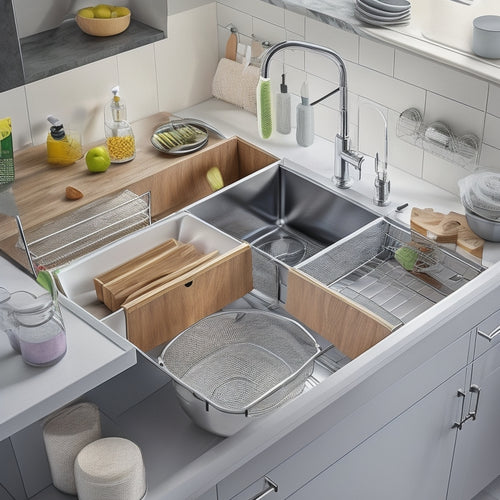
Chevrolet Camaro Repair Manual: Expert Maintenance Tips
Share
You're about to unleash the full potential of your 1982-1992 Chevrolet Camaro. Begin by understanding the purpose and scope of your repair manual, which covers routine maintenance, servicing, diagnostic procedures, and repair guidance. It's crucial to familiarize yourself with troubleshooting techniques and safety precautions like wearing gloves and safety glasses. Regularly check fluid levels, tire pressure, and essential systems to maintain proper traction and fuel efficiency. Perform regular engine and transmission maintenance, and consider performance upgrades like air intake systems. By following these expert tips, you'll be well on your way to optimizing your Camaro's value, and there's more to explore.
Key Takeaways
• Regularly check and maintain essential systems, including fluid levels, tire pressure, air filter, spark plugs, and belts, to prevent engine damage.
• Familiarize yourself with troubleshooting techniques and follow proper installation procedures for performance upgrades like air intake systems.
• Wear safety equipment, ensure a well-ventilated workspace, and disconnect the battery before starting work to ensure safe and efficient task completion.
• Refer to the routine maintenance checklist and follow manufacturer's instructions for valve adjustments, sealant application, and torque specifications during component replacement.
• Perform regular engine and transmission maintenance, including fluid level checks and top-offs, to optimize the value of your 1982-1992 Camaro model.
Manual Overview and Essentials
Before you begin exploring the world of Chevrolet Camaro repair and maintenance, it's important to grasp the purpose and scope of this manual, which is designed to assist you in optimizing the value of your 1982-1992 Camaro, Berlinetta, or Z-28 model.
This detailed guide covers essential topics, including routine maintenance, servicing, diagnostic procedures, and repair guidance. Familiarize yourself with troubleshooting techniques to identify common issues and take preventive measures to avoid costly repairs.
Additionally, learn about fluid recommendations for your vehicle, ensuring you use the right type and capacity for engine oil, brake fluid, transmission lubricant, and more.
Safety Precautions and Guidelines
As you prepare to tackle maintenance and repair tasks on your Chevrolet Camaro, prioritize your safety by familiarizing yourself with the critical guidelines and precautions outlined in this section to avoid personal injury and prevent component damage.
Always wear safety equipment, such as gloves and safety glasses, to protect yourself from sharp edges and flying debris. Make sure your workshop is well-ventilated and free from distractions. Follow proper workshop procedures, like disconnecting the battery before starting work, to prevent electrical shock.
Read each procedure carefully, and don't skip steps or assume you can improvise. By adhering to these safety guidelines, you'll be able to complete your tasks efficiently and safely.
Engine and Transmission Maintenance
You'll need to perform regular engine and transmission maintenance to make sure your Chevrolet Camaro runs smoothly, efficiently, and reliably over its lifespan. Regular fluid checks are vital, as low levels or contaminated fluids can cause serious damage. Check your engine oil, transmission fluid, and coolant levels regularly, and top them off as needed.
Troubleshooting common issues like overheating, stalling, or slipping can help prevent major repairs. If you're looking to upgrade your Camaro's performance, consider modifications like air intake systems, exhaust systems, or engine tuning. However, always make sure that any upgrades are compatible with your vehicle's specifications and follow proper installation procedures to avoid compromising safety and performance.
Routine Maintenance and Inspections
Check your Chevrolet Camaro's essential systems regularly to catch potential issues before they become major problems, and refer to the routine maintenance checklist in this manual for guidance.
You'll want to inspect your vehicle's fluid levels, including engine oil, transmission fluid, and brake fluid, to make sure they're at the recommended levels.
Additionally, check your tire pressure at least once a month, and before long trips, to maintain proper traction and fuel efficiency.
Regularly inspect your air filter, spark plugs, and belts to prevent engine damage.
Component Replacement and Installation
Replace valve train components, such as lifters or rocker arms, with new parts whenever you detect excessive wear or noise. Ensure proper sealant application and precise torque specifications to maintain engine performance and prevent damage.
When replacing these components, make sure to follow the manufacturer's instructions for valve adjustments. This will guarantee proper clearance and prevent premature wear. Additionally, apply the correct sealant to prevent oil leaks and ensure a secure fit.
Remember to refer to your repair manual for specific torque specifications and procedures to avoid damaging your engine. By following these steps, you'll be able to replace valve train components safely and efficiently, keeping your Camaro running smoothly.
Electrical and Brake System Repair
When diagnosing electrical system faults in your Chevrolet Camaro, start by consulting the wiring diagrams and circuit descriptions in your repair manual to identify the affected components and their locations. This will help you perform accurate wiring diagnostics and pinpoint the source of the issue.
Next, inspect the wiring and connections for signs of damage or corrosion, and repair or replace them as needed. Additionally, pay attention to your brake system, as faulty electrical components can affect brake performance.
Regular brake fluid maintenance is essential, so be sure to check the fluid level and condition regularly, and top it off or replace it as necessary. By following these steps, you'll be able to identify and fix electrical and brake system issues in your Camaro, ensuring a safe and reliable ride.
Suspension and Steering System Care
Properly functioning suspension and steering systems are crucial to your Chevrolet Camaro's handling and stability, making regular maintenance and inspections important to guaranteeing a smooth, responsive ride.
To keep your Camaro running smoothly, follow these critical maintenance tips:
-
Check steering fluid levels: Confirm the power steering fluid reservoir is at the recommended level to prevent damage to the system's components.
-
Perform alignment adjustments: Regularly check and adjust the alignment of your Camaro's wheels to maintain even tire wear and prevent uneven handling.
-
Inspect suspension components: Regularly inspect shock absorbers, struts, and springs for signs of wear or damage, and replace them as needed to maintain a safe and stable ride.
Frequently Asked Questions
How Do I Troubleshoot a Faulty Air Conditioning Compressor Clutch?
You'll troubleshoot a faulty air conditioning compressor clutch by checking for compressor failure signs, such as overheating or noise, then inspecting the clutch relay, fuse, and wiring; if necessary, replace the clutch to guarantee safe and efficient AC operation.
What Causes Excessive Wear on the Camaro's Rear Tires?
You're experiencing excessive wear on your Camaro's rear tires, likely due to improper tire pressure or aggressive driving habits, such as rapid acceleration, braking, or cornering, which can cause uneven tire wear and reduced tire life.
Can I Upgrade My Camaro's Engine to a High-Performance Variant?
You're probably aware that a single misaligned wheel can cause 10% of your tire's tread to wear down in just 1,000 miles. Now, about that engine upgrade: yes, you can swap in a high-performance variant, but engine swaps require meticulous planning to guarantee safe performance gains.
How Do I Diagnose and Repair a Faulty Speedometer Cable?
You'll need to inspect the speedometer cable routing for kinks or damage, then recalibrate the speedo using a multimeter to diagnose the fault, ensuring accurate readings and safe driving practices.
What Are the Recommended Wheel Bolt Torque Specifications for My Camaro?
When checking your Camaro's wheel bolt torque, make sure you refer to the recommended specifications to avoid wheel damage or loss. For proper wheel alignment, tighten lug nuts in a star pattern to the specified torque value, usually between 90-120 ft-lbs, depending on your model year.
Related Posts
-

Boost Productivity With Free Google Sheets Templates
You can enhance your productivity exponentially by utilizing free Google Sheets templates, which offer a proven way t...
-

LYNK PROFESSIONAL: Transform Your Under-Sink Storage
Transform your under-sink storage with LYNK PROFESSIONAL, a cleverly designed system that tackles common challenges. ...

